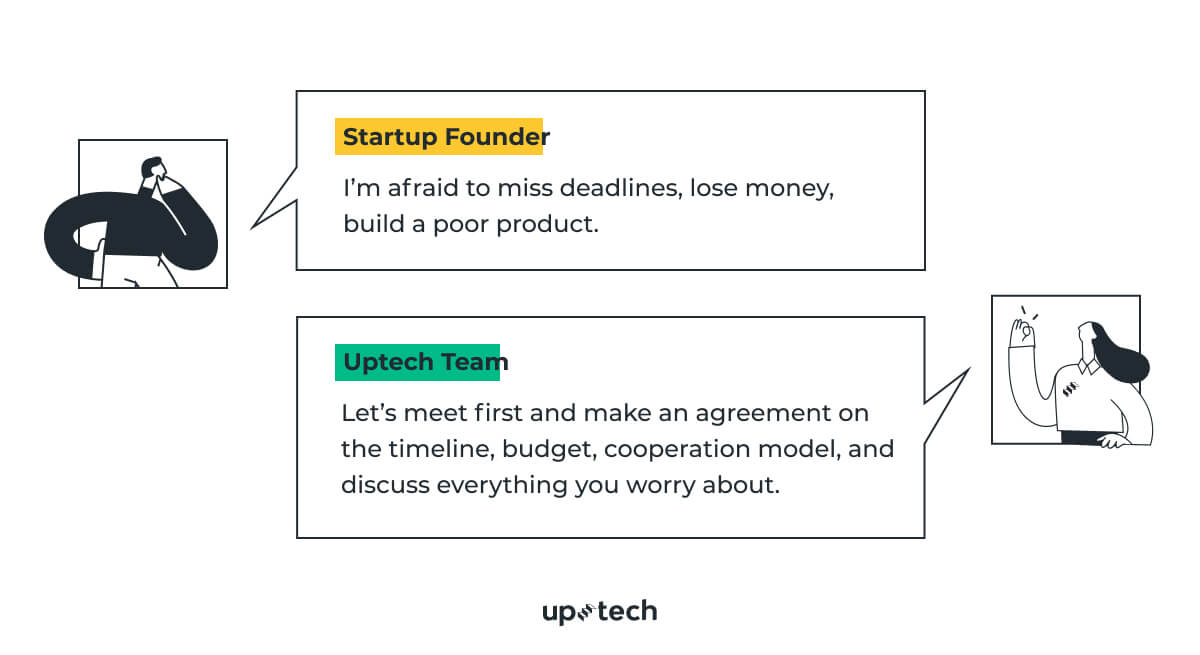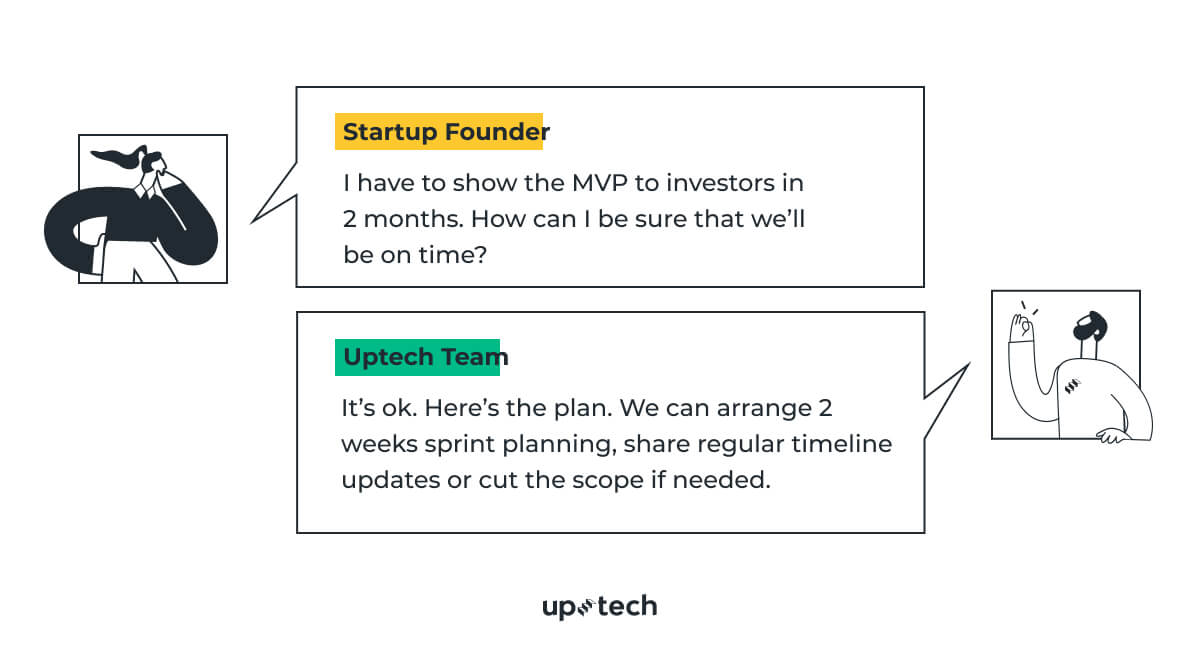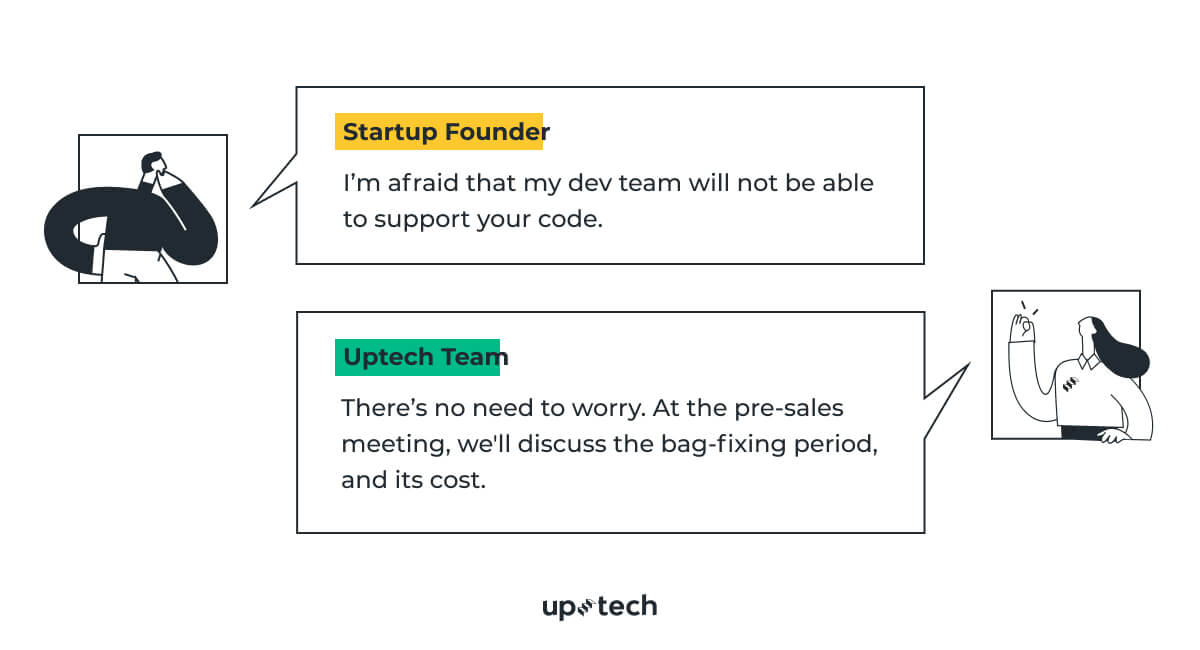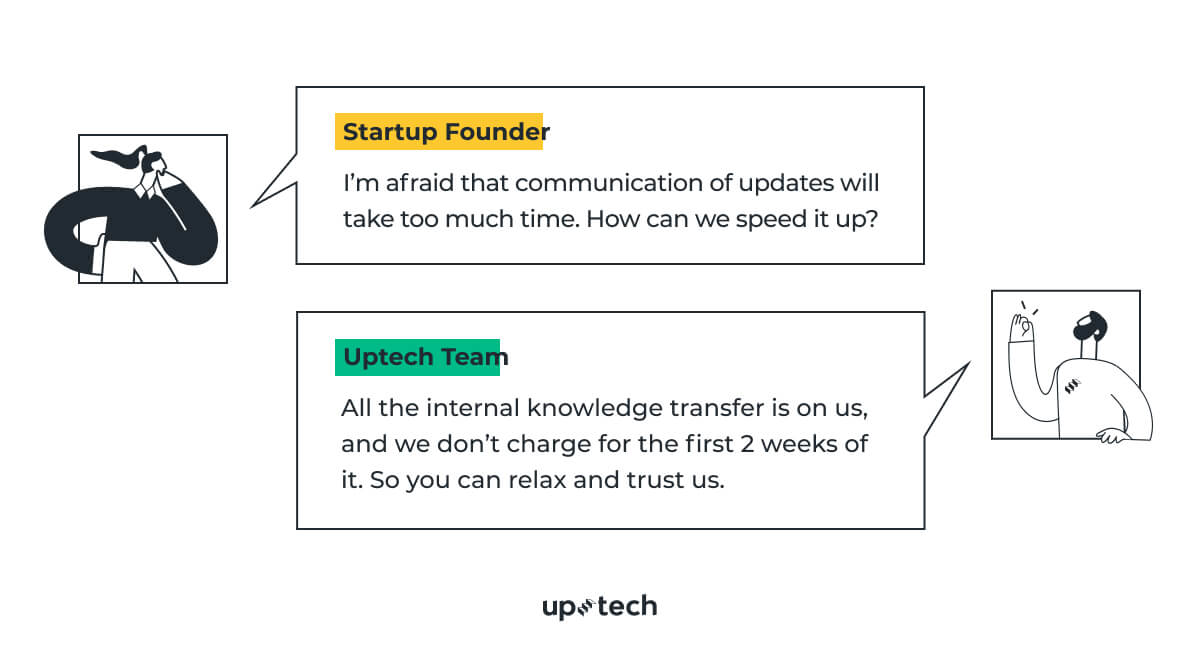Jagdish Dalal, CEO of Corporate Affairs, once said, "Companies are past the basics of talking about outsourcing and offshoring. Executives understand outsourcing now and want to know how to effectively use it in their organizations."
So, the idea is that IT outsourcing isn't a simple cost reduction technique anymore. It helps startups and established businesses to grow, improve customer experience, and gives them a competitive advantage. I can sum up and say that IT outsourcing is a viable solution worth considering.
Still, things aren't as easy. Like everything, outsourcing isn’t perfect. It has stereotypes that come from the earliest days when the industry was just evolving. But there are ways to avoid certain challenges of outsourcing, and that is what I’ll talk about in this article.
I’ve been working with startup founders, product owners for 7 years and heard their pains. Here are some of the most common problems that I've discovered along with mitigative measures.
10 Most Common Problems of Outsourcing
IT outsourcing is a strategic solution for businesses seeking to optimize costs and speed up development. A staggering 92% of G2000 companies use IT outsourcing and 37% of small businesses outsource at least one business process to get access to specialized skills and reduce operational expenses. However, while outsourcing offers numerous benefits, it also presents its own set of challenges that can impede success.
Below we'll discover the 10 most common problems associated with IT outsourcing and provide actionable solutions to mitigate these concerns, ensuring a smoother outsourcing experience for businesses of all sizes.
Problem #1 A Company Doesn’t Meet My Expectations

Finding the outsourcing company that perfectly meets your expectations isa tall order. It's always a two-player game, you – a startup founder and us – a prospective partner. One side may have one vision, and another has a different one.
Why does the problem arise? Poor communication at the pre-sales stage, unclear agreements, or a lack of one.
How to solve it? To avoid such outsourcing issues you should define criteria you value and create a score table. Send a similar request for proposal and evaluate each company.
We at Uptech practice pre-sales meetings where we discuss the expectations about the following:
- Timeline;
- Budget;
- Decision-making process;
- Cooperation model;

If something was missed, we send a document where we ask clarifying questions. Yes, we dig deep, and it takes time.
It's naïve to think that 99% of the work can be planned beforehand. The planning horizon requires more or less 2 weeks, and from my experience, it's the bare minimum needed to mitigate the risk.
It's naïve to think that 99% of the work can be planned beforehand. The planning horizon is more or less 2 weeks.
Problem #2 My Project Has Run Out of Money

In the startup world, lack of money is often the reason for shutting down. And it's ok. 38% of startups fail because of this. But if all entrepreneurs had quit their ideas because of this statistic, there would be no Slack, no Uber, and other life-saving products. If it happens that your project runs out of money, here's my advice.
Why does the problem arise? For many reasons, from miscommunication at the pre-sales stage to the investors, market changes, pandemia, etc.
How to solve it? There are several ways out.
- We propose to simplify the product. What do I mean? Reduce the scope, remove some 'nice-to-have features, postpone some functionality to the next product version.
- Another option is sharing financial projections. It helps to prevent financial problems when outsourcing and I genuinely recommend this approach. Here's how it works at Uptech. We agree on sharing the financial report and payment invoice at the end of each month with our clients. Some founders like to have an even bigger picture and ask us to prepare the monthly balance sheet with the following information: money spent, money rest, expected expenses.
I do respect such a meticulous approach. The client always has a tight rein on the project, and there are fewer chances that some unexpected moments will arise.
Problem #3 Strong Sales Team but Weak Project Team

Falling in love with the sales team is often a problem because it may lead to (again) unmet expectations. As a Business Development Manager, I can tell you for sure that it's the sales team's job to attract clients and make them sign the contract.
But when things come to day-to-day work, the sales team, like the host of the show, hides behind the scenes, and the actors come to the stage. And this is where the problem arises. The project team may have weaker communications skills, you may not like their approach to work, or simply can't find common ground.
Why does the problem arise? Unspoken or unclear expectations.
How to solve it? I can't stress it enough, but if the reason lies in lack of communication, the solution is to sit and talk. We at Uptech arrange an introduction meeting to prevent this problem in the future. It's where the client can meet a project team, put a face to a name and understand the team's structure. It’s a perfect time to tell about your idea, challenges you want to solve, goals and introduce the in-house team engaged in the project from your side.
Another solution to this outsourcing problem is – Account manager. We at Uptech have several Account managers who are assigned to our clients. If a client has any questions, concerns, unsatisfied needs, the Account manager is precisely that person to address to. Consider the Account manager as the mediator between you and the project team.
Problem #4 Delays and Missed Timelines

With sudden market changes, uncertain product vision, and a chaotic startup environment, it's easy to lose track of time. I often hear our clients highlighting the importance of delivering the tasks on time. And I understand them. Every day is as precious as gold when you create a startup, and investors may ask to show results as soon as possible. Quite stressful.
Why does the problem arise? Timeline expectations weren't communicated clearly, the scope of work changed very often, task evaluation done wrong, a client didn't share feedback on time, etc.
How to solve it? The solution varies from reason to reason. Let's go over each:
- Miscommunicated timelines. You, as a startup founder, should share the expected date of release. It would be very nice to set the deadlines for the key features and factor in the possible time shifts. From our side, we arrange sprint planning, at which we plan the scope for 2 weeks.
- Changed scope of work. The best solution is to simplify the scope and postpone some nice-to-have features to the next release.
- Wrong task evaluation. As soon as we notice that the task will take us a month instead of 2 weeks as we estimated, we communicate it. Then things are about setting a good strategy. What do I mean? Cut the scope and simplify the features where possible.
- Delayed client's feedback. If that happens, we set an agreement that you as a product owner should check the work done every week and come back with feedback within 3 working days. Moving in small steps leads to success.
Problem #5 Poor Code that Can’t Be Supported

Buy nice, but twice. It's difficult to be 100% sure that your prospective partner will deliver the product with no bugs, but it's possible. Often, you'll be troubled with – small bugs, unreachable code, no architecture, etc.
Why does the problem arise? Unclear project requirements.
How to solve it? Before the development starts, define your quality standards and share requirements with a team. Add them to the Contract and check regularly. It’s also wise to ask some clarifying questions at the pre-sales meetings.
- How long is the bug-fixing period?
- What are the guarantees that the bugs will be fixed?
- Is it free or not? If not, how much it costs.
You can also read reviews on the rating&review platforms such as Clutch. Look for the company's portfolio, its approach.
Problem #6 I’m Afraid to Lose Control Over The Process

Every project requires a massive and collective engagement on both sides to turn an idea into a successful product. I know how important it is for startup founders to keep track of everything happening on the project. And outsourcing may seem like hiring a nanny for a child. But you can leverage your control.
Why does the problem arise? Lack of communication between the client and the product team.
How to solve it? Leveraging control is possible when you set up the communication process between the client and product team. For example, you may ask an Account manager to send you one message with the work done and links to check it out. Or setting up the calls with the product team every week or biweekly. Regular check-ins and reports will help here.
Problem #7 Time Zone Difference

Many Uptech's clients are from the US, which means they wake up and have their morning cups of coffee when we shut down our laptops for family dinners.We've been working effectively according to such a schedule for 5 years, so here are some tips to solve time zone issues while outsourcing.
Why does the problem arise? Well, we live on the opposite sides of the Globe.
How to solve it? Here's how we solve this problem at Uptech. At the kick-off call, we agree on some rules: starting from 7 to 9 a.m PST, we are available for meetings. After that, we stay online for text communication in Slack for at least 2 hours. We also make an agreement that clients check the work done early in the morning, leave comments, and we reply to them in real-time. We go offline after figuring out all the questions. Our rule is to never leave a question open.
Problem #8 Knowledge Transfer is Hard and Long

Transferring knowledge is an inevitable part of outsourcing. And the success of the product partly depends on how well the knowledge transfer was done. If the knowledge transfer was poor, unfinished, incomplete – there will be negative consequences.
Why does the problem arise? It often arises for the established companies that already have a working process. Startups are more flexible.
How to solve it? Transparent communication scores, again. The golden rule here is to discuss how the knowledge transfer will happen in advance and document everything.
For example, there could be a situation when the engineer who worked on the project initially has to leave. And another one replaces him/her. In this case, we propose 2 weeks of onboarding for the newbie, and the client doesn't pay for these 2 weeks.
Problem #9 Lost in Translation

US companies are the biggest outsourcers. And India, the Philippines, Poland, and Ukraine are the top countries to outsource. So language and cultural barriers are common problems of outsourcing.
Why does the problem arise? I can refer to the Tower of Babel myth but let's say that it was just circumstances.
How to solve it? It's hard to create a successful product with people that you don't speak a common language. So, check if people from the outsourcing company speak English while you'reresearching. It'll save you time and resources.
Problem #10 I’m Worried About the Legal Issues

I saved this one for dessert. The issues of confidentiality, compliance, liability, data protection, and intellectual property rights may seem like horror titles for entrepreneurs. And they often create some problems in IT outsourcing.
Why does the problem arise? Insufficient examination of the Contract and not well-documented agreements.
How to solve it? Study the Contract from top to bottom. Don't gloss it over, you're the party concerned with the product's success, and it's your responsibility to check all the project's details. Examine the cooperation model you choose because each has its legal terms. Hire a financier to help you to inspect your contract.

Golden Rules to Avoid Problems with Outsourcing
The project falls flat if it's left to chance. That's why I highlighted the importance of caring for the project, digging into the tiniest details, and exploring every step of collaboration. You come with an idea to create something that matters for the world and equally to you. The project's result is the sum of your contribution and those of your partner. So here are three golden rules I'd like you to follow to reach the highest possible outcome.
- Be meticulous when researching the outsourcing company;
- Share your product's details as much as possible;
- Invest in your relationship with a team and treat them as equal partners;
Engagement and trust bring a product to the next level and lead to smooth communication.

Summing Up
Everyone wants to work with nice people and achieve top results together, but there may be blockers on the way. There are several current challenges in outsourcing, from time zone differences to legal issues. Though some problems seem hard to solve, there's always a way out.
If you find a common language with your partner, share the same goal, and respect each other – I truly believe that you'll manage to build a strong collaboration, foster ingenuity, and space to do your best work.











































































.avif)
























